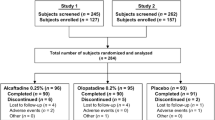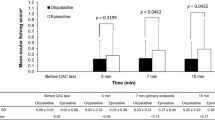Abstract
Purpose
Our purpose was to investigate the effect of locally administered cis-urocanic (cis-UCA) in two experimental models of allergic conjunctivitis.
Methods
The compound 48/80 (C48/80)-induced ocular irritation model (IgE-independent) and the ovalbumin (OA)-induced ocular allergy model (IgE-mediated) were used to test and compare the effect of cis-UCA on dexamethasone, ketotifen and olopatadine. In the C48/80 model, clinical severity scoring from photographs, immunohistochemical analysis of nuclear Ki-67 antigen to quantify actively proliferating epithelial cells and of caspase-3 enzyme to identify apoptotic activity in the conjunctival tissue were used. In the OA model, an Evans Blue stain concentration of conjunctival tissue was used to evaluate vascular leakage due to allergic reaction.
Results
The cis-UCA was well tolerated and effective in both the IgE-independent and -mediated rat models. Treatment with C48/80 caused conjunctival hyperaemia, which was significantly inhibited by ketotifen at the 6 h time point (p = 0.014) and by dexamethasone and cis-UCA 0.5% at 12 (p = 0.004) and 24 (p = 0.004) hour time points. In a comparison between the active drug treatments, only ketotifen showed a significant difference (p = 0.023) to cis-UCA treatment at the 1 h time point, otherwise there were no statistically significant differences between the active drugs. Ketotifen, dexamethasone and cis-UCA 0.5% significantly inhibited the C48/80-induced nuclear accumulation of Ki-67, without differences between the active treatment groups. In the OA model, cis-UCA 0.5% did not inhibit the vascular leakage of conjunctiva, whereas cis-UCA 2.5% of was at least equally effective compared to olopatadine, abolishing the allergic vascular leakage response almost completely.
Conclusions
The present findings in the two AC models suggest that cis-UCA might have anti-allergic potency both in immediate and delayed-type allergic reactions in the eye.



Similar content being viewed by others
References
Bielory L (2011) Ocular allergy. Mt Sinai J Med 78:740–758
Irkec MT, Bozkurt B (2012) Molecular immunology of allergic conjunctivitis. Curr Opin Allergy Clin Immunol 12:534–539
Pauly A, Brasnu E, Riancho L, Brignole-Baudouin F, Baudouin C (2011) Multiple endpoint analysis of BAC-preserved and unpreserved antiallergic eye drops on a 3D-reconstituted corneal epithelial model. Mol Vis 17:745–755
Erdinest N, Solomon A (2014) Topical immunomodulators in the management of allergic eye diseases. Curr Opin Allergy Clin Immunol 14:457–463
Syed BA, Kumar S, Bielory L (2014) Current options and emerging therapies for anterior ocular inflammatory disease. Curr Opin Allergy Clin Immunol 14:485–489
Bjorklund S, Andersson JM, Pham QD, Nowacka A, Topgaard D, Sparr E (2014) Stratum corneum molecular mobility in the presence of natural moisturizers. Soft Matter 10:4535–4546
Barresi C, Stremnitzer C, Mlitz V, Kezic S, Kammeyer A, Ghannadan M, Posa-Markaryan K, Selden C, Tschachler E, Eckhart L (2011) Increased sensitivity of histidinemic mice to UVB radiation suggests a crucial role of endogenous urocanic acid in photoprotection. J Invest Dermatol 131:188–194
Lauerma AI, Aioi A, Maibach HI (1995) Topical cis-urocanic acid suppresses both induction and elicitation of contact hypersensitivity in BALB/C mice. Acta Derm Venereol 75:272–275
Ross JA, Howie SE, Norval M, Maingay J, Simpson TJ (1986) Ultraviolet-irradiated urocanic acid suppresses delayed-type hypersensitivity to herpes simplex virus in mice. J Invest Dermatol 87:630–633
Dahl MV, McEwen GN Jr, Katz HI (2010) Urocanic acid suppresses induction of immunity in human skin. Photodermatol Photoimmunol Photomed 26:303–310
Rinaldi M, Moroni P, Leino L, Laihia J, Paape MJ, Bannerman DD (2006) Effect of cis-urocanic acid on bovine neutrophil generation of reactive oxygen species. J Dairy Sci 89:4188–4201
Bannerman DD, Rinaldi M, Vinyard BT, Laihia J, Leino L (2009) Effects of intramammary infusion of cis-urocanic acid on mastitis-associated inflammation and tissue injury in dairy cows. Am J Vet Res 70:373–382
Peltonen JM, Pylkkanen L, Jansen CT, Volanen I, Lehtinen T, Laihia JK, Leino L (2014) Three randomised phase I/IIa trials of 5% Cis-urocanic acid emulsion cream in healthy adult subjects and in patients with atopic dermatitis. Acta Derm Venereol 94:415–420
Viiri J, Jauhonen HM, Kauppinen A, Ryhanen T, Paimela T, Hyttinen J, Sorri I, Laihia JK, Leino L, Kaarniranta K (2009) Cis-urocanic acid suppresses UV-B-induced interleukin-6 and -8 secretion and cytotoxicity in human corneal and conjunctival epithelial cells in vitro. Mol Vis 15:1799–1805
Jauhonen HM, Kauppinen A, Paimela T, Laihia JK, Leino L, Salminen A, Kaarniranta K (2011) Cis-urocanic acid inhibits SAPK/JNK signaling pathway in UV-B exposed human corneal epithelial cells in vitro. Mol Vis 17:2311–2317
Pflugfelder SC, de Paiva CS, Tong L, Luo L, Stern ME, Li DQ (2005) Stress-activated protein kinase signaling pathways in dry eye and ocular surface disease. Ocul Surf 3:154–157
Tiligada E, Aslanis D, Delitheos A, Varonos D (2000) Changes in histamine content following pharmacologically-induced mast cell degranulation in the rat conjunctiva. Pharmacol Res 41:667–670
Calonge M, Siemasko KF, Stern ME (2003) Animal models of ocular allergy and their clinical correlations. Curr Allergy Asthma Rep 3:345–351
Sheldon WH, Bauer H (1960) Tissue mast cells and acute inflammation in experimental Cutaneous Mucormycosis of normal, 48/80-treated, and diabetic rats. J Exp Med 112:1069–1084
Dartt DA, Masli S (2014) Conjunctival epithelial and goblet cell function in chronic inflammation and ocular allergic inflammation. Curr Opin Allergy Clin Immunol 14:464–470
Allansmith MR, Baird RS, Ross RN, Barney NP, Bloch KJ (1989) Ocular anaphylaxis induced in the rat by topical application of compound 48/80. Dose response and time course study. Acta Ophthalmol Suppl 192:145–153
Groneberg DA, Bielory L, Fischer A, Bonini S, Wahn U (2003) Animal models of allergic and inflammatory conjunctivitis. Allergy 58:1101–1113
Khosravi E, Elena PP, Hariton C (1995) Allergic conjunctivitis and uveitis models: reappraisal with some marketed drugs. Inflamm Res 44:47–54
Scholzen T, Gerdes J (2000) The Ki-67 protein: from the known and the unknown. J Cell Physiol 182:311–322
Ohara M, Sotozono C, Tsuchihashi Y, Kinoshita S (2004) Ki-67 labeling index as a marker of malignancy in ocular surface neoplasms. Jpn J Ophthalmol 48:524–529
Abu El-Asrar AM, Al-Mansouri S, Tabbara KF, Missotten L, Geboes K (2006) Immunopathogenesis of conjunctival remodelling in vernal keratoconjunctivitis. Eye (Lond) 20:71–79
Calonge MC, Pastor JC, Herreras JM, Gonzalez JL (1990) Pharmacologic modulation of vascular permeability in ocular allergy in the rat. Invest Ophthalmol Vis Sci 31:176–180
Calonge M, Montero JA, Herreras JM, Ramon JJ, Pastor JC (1996) Efficacy of nedocromil sodium and cromolyn sodium in an experimental model of ocular allergy. Ann Allergy Asthma Immunol 77:124–130
Sanchis-Merino ME, Montero JA, Ruiz-Moreno JM, Rodriguez AE, Pastor S (2008) Comparative efficacy of topical antihistamines in an animal model of early phase allergic conjunctivitis. Exp Eye Res 86:791–797
Tamura T (2012) Olopatadine ophthalmic solution suppresses substance P release in the conjunctivitis models. Asia Pac Allergy 2:115–121
Jauhonen HM, Kari E, Pylkkanen L, Poutanen J, Laihia J, Kaarniranta K, Leino L (2015) A randomized phase I clinical study of cis-urocanic acid eye drops in healthy adult subjects. Acta Ophthalmol 93:368–376
Funding
No funding was received for this research.
Author information
Authors and Affiliations
Corresponding author
Ethics declarations
Conflict of interest
All authors certify that they have no affiliations with or involvement in any organization or entity with any financial interest (such as honoraria; educational grants; participation in speakers’ bureaus; membership, employment, consultancies, stock ownership, or other equity interest; and expert testimony or patent-licensing arrangements), or non-financial interest (such as personal or professional relationships, affiliations, knowledge or beliefs) in the subject matter or materials discussed in this manuscript.
Ethical approval
All applicable international, national, and institutional guidelines for the care and use of animals were followed. All procedures performed in studies involving animals were in accordance with the ethical standards of the institution at which the studies were conducted.
Rights and permissions
About this article
Cite this article
Jauhonen, HM., Laihia, J., Oksala, O. et al. Topical cis-urocanic acid prevents ocular surface irritation in both IgE -independent and -mediated rat model. Graefes Arch Clin Exp Ophthalmol 255, 2357–2362 (2017). https://doi.org/10.1007/s00417-017-3781-z
Received:
Revised:
Accepted:
Published:
Issue Date:
DOI: https://doi.org/10.1007/s00417-017-3781-z




